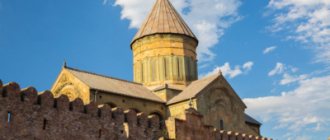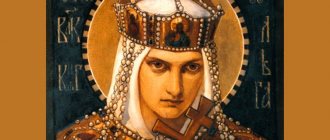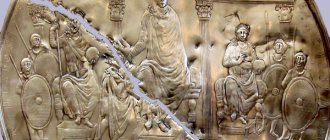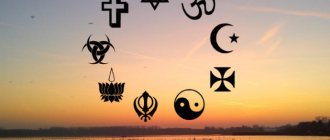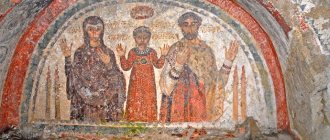Saint Nina, Equal to the Apostles, is considered the patroness of Georgia, since it was thanks to her sermons that the inhabitants of Iveria (present-day Georgia) converted to the Christian faith.
The Georgian Orthodox Church is one of the oldest in the Christian world. On May 6, 319, the Georgian king Mirian, healed of blindness by Saint Nina, converted to Orthodoxy.
Holy Equal to the Apostles Nina. Photo: Commons.wikimedia.org
On the advice of Nina, the king turned to the Byzantine emperor Constantine (306–337) with a request to send a bishop and priests to perform the sacrament of baptism over the people who had previously believed in pagan gods. The baptism of Georgia on the Kura River took place in 324 (according to other sources, in 326).
Girl from Cappadocia
Saint Nina Equal to the Apostles was born around 280 in Cappadocia. Her father, Zabulon, came from a noble family and was in the military service of Emperor Maximian, and her mother, Susanna, was the sister of the Jerusalem Patriarch Juvenal.
Nina was the only child of her parents. When the girl was 12 years old, she and her parents came to Jerusalem, where her mother became a deaconess at the Church of the Holy Sepulcher, and her father devoted his life to serving God in the deserts of Jordan.
Protestantism
Main article: Protestantism in Georgia
The first Protestants on the territory of modern Georgia were Lutheran Germans, who began to settle in the region starting in 1817. In 1867, in Tiflis, the former Molokan Nikita Voronin was rebaptized according to the Baptist rite, becoming the first Russian Baptist. Since 1904, Adventists have been preaching in Georgia. OK. In 1929, the first Pentecostal church arose in Georgia.
Currently, according to various estimates, from 20 to 34 thousand Protestants and parishioners of free non-denominational churches live in the country[5][6]. The largest groups of them are Pentecostals (12.3 thousand[6]) and Baptists (10 thousand[7]).
Tales and dreams about the country of Iberia
At the age of 12, Nina was entrusted to be raised by Elder Nianfora, who often told her about Iveria (present-day Georgia), then still a pagan country. Hearing her stories, Nina wanted to visit Iberia.
One day the Most Pure Virgin appeared to Nina in a dream and handed over a cross woven from a vine, with the words: “Take this cross, it will be your shield and fence against all visible and invisible enemies. Go to the country of Iveron, preach the Gospel of the Lord Jesus Christ there and you will find grace from Him. I will be your Patroness.”
Having awakened, Saint Nina saw a cross in her hands (now kept in a special ark in the Tbilisi Zion Cathedral), she rejoiced in spirit and, coming to her uncle, the Patriarch of Jerusalem, told about the vision. The Patriarch of Jerusalem blessed the young virgin for the feat of apostolic service.
Cross of St. Nina. Photo: wikipedia.org
Another time, the Savior appeared to Nina and gave her a scroll in which it was written: “Go and teach all nations, baptizing them in the name of the Father, and the Son, and the Holy Spirit” (Matthew 28:19).
Relations between the Georgian and Russian Orthodox Churches
A review of the similarities and differences of our churches will be incomplete without recalling the love that has been created and increased over the centuries and which now unites the “sister” churches.
The Georgian and Russian churches became close and friendly during the years of the Golden Horde, when their representatives met during the payment of taxes. The friendship that began in common misfortune turned out to be strong and long-lasting.
Then Rus' helped Georgia fight external enemies. Back in the 15th century, the Georgian Tsar Alexander I turned to Grand Duke Ivan III for protection, and at the beginning of the 19th century, the Georgian Tsar completely “handed over his people to Russia.”
From ancient times until the 19th century, interchurch relations were strengthened thanks to the monks of the Georgian and Russian monasteries on Mount Athos.
A remarkable phenomenon in the development of spiritual ties between our churches was the Georgian icons brought to Russia and which became the subject of deep veneration. This is, first of all, a copy of the miraculous Iveron Icon of the Blessed Virgin Mary, brought in the mid-17th century from the Iveron Monastery on Mount Athos, as well as other miraculous icons of the Mother of God: “Okonskaya” (18th century) and “Gruzinskaya”.
In the 19th century, relations between the Russian and Georgian churches were most constant, as the Georgian Church was governed by exarchs appointed by the Russian Holy Synod.
And finally, strong fraternal relations developed between the Georgian and Russian churches in the mid-20th century thanks to their restoration of prayerful communication. Currently, Georgia and Russia, as well as their local churches, have many points of contact, joint projects and, most importantly, close mutual prayer communication.
What do the Georgian and Russian churches have in common?
As we can see from the above history, there was a time when the Georgian Church was part of the Russian Orthodox Church. This happened when Georgia was “beyond friendly bayonets,” from 1801 to 1917. Then the Georgian Church again became an autocephalous local Orthodox Church. From this we can conclude that our churches do not have dogmatic differences and differences in doctrine.
At the moment, the Russian and Georgian Orthodox churches are “sisters” and stand side by side in the diptych (list) of 15 local churches along with Constantinople, Jerusalem, American and others. They all have apostolic succession. What does it mean? The first bishops of the Ecumenical Orthodox Church were ordained for ministry by the apostles, disciples of Jesus Christ. Then these bishops ordained priests, and this is what happens in our time. It turns out that if you take any active priest, you can trace the chain of ordination back through the centuries to one of the 12 apostles. This is called apostolic succession, which has always been the main hierarchical principle of the unity of the Universal Church. It turns out that both the Russian and Georgian churches, like the other 13 local churches, do not differ in the main thing - in doctrine and apostolic succession, and are separated only organizationally. Moreover, what is important, the serial number in the diptych does not matter: all local churches are equal. Only Constantinople is historically considered “first among equals.”
How does the Georgian Church differ from the Orthodox Russian Church?
As we have already found out, Georgians and Russians are brothers in faith and members of the Universal Church of Christ. Russian people have always been welcomed into a Georgian monastery or temple, and Georgians into a Russian one. For example, it is surprising, but the main Georgian Orthodox church in Moscow - the Church of the Great Martyr George the Victorious in Gruzini - belongs to the Russian Church.
In the main thing, in doctrine, our churches are united. There are differences between the Georgian Orthodox Church and the Russian Orthodox Church, although small. Each of them has its own history, its own language in which services take place, its own devotees of piety and revered shrines.
First of all, the Georgian Orthodox Church (GOC) is older than the Russian (as the Russian Orthodox Church was called before the 1917 revolution). The GOC was formed in 337, when, as we already know, thanks to Equal-to-the-Apostles Nina, Christianity became the state religion in Georgia. The baptism of Kievan Rus took place in 988 through the labors of Saint Prince Vladimir. It turns out that the Georgian Church is 651 years older, it is one of the oldest Christian churches in the world.
Sources
- https://travelkap.club/gruziya/prinyatie-hristianstva/index.html
- https://aif.ru/dontknows/file/kogda_i_blagodarya_komu_gruziya_stala_pravoslavnoy
- https://switki.ru/477848a-gruzinskaya-pravoslavnaya-tserkov-istoriya-i-osobennosti-otlichie-ot-russkoy-pravoslavnoy-tserkvi
- https://GruziyaGid.ru/kultura/pravoslavie-v-gruzii
- https://borovscoe.ru/prochee/kto-ranshe-prinyal-hristianskuyu-veru-armyane-ili-gruziny.html
[collapse]
Share on social media networks3>
Baptism of Georgia
Having received the blessing of the patriarch and mother, Nina set off on the road. On the way to Iveria, Saint Nina miraculously escaped martyrdom from the Armenian king Tiridates, to which her companions - Princess Hripsimia, her mentor Gaiania and 35 girls who fled to Armenia from Rome from the persecution of Emperor Diocletian (284-305) - were subjected.
Nina reached Iberia in 319. Entering Mtskheta, the ancient capital of Georgia, Saint Nina found shelter in the family of a childless royal gardener, whose wife, Anastasia, through the prayers of Saint Nina, was relieved of infertility and believed in Christ.
Very soon Nina became famous in the surrounding area, helping many suffering people. Having learned about the power of her prayers, people began to come to her. Many of them believed in God and were baptized.
Saint Nina healed the Georgian Queen Nana from a serious illness, who also received baptism and became a zealous Christian. King Mirian, despite the miraculous healing of his wife, listening to the pagans, hated Saint Nina and even wanted to put her to death. But one day while hunting he was caught in a thunderstorm, and he was blinded by lightning. The king promised to convert to Christianity if his sight returned. Saint Nina healed a supporter of paganism, and Mirian, along with his retinue, was baptized.
The chronicles tell that, through her prayers, it was revealed to Saint Nina where the Robe of the Lord was hidden, and the first Christian church in Georgia was erected there (initially a wooden, now a stone cathedral in honor of the 12 holy Apostles, Svetitskhoveli).
After several years, in 324, Christianity finally established itself in Iberia. A few years later, Nina went to Kakheti, where she converted Queen Sophia to Christianity.
Svetitskhoveli Cathedral in Mtskheta. Photo: RIA Novosti / Alexey Kudenko
How do the Armenian and Georgian churches differ from the Russian one? Georgia Orthodox
Georgia is the Transcaucasian country closest to Russia, with which it is connected not only by faith, and the baptism of Georgia occurred 664 years before the baptism of Rus', but by history and culture. Many glorious names of Orthodox saints, kings, great generals, poets, writers, musicians and actors connect the two great countries. But the most important thing is the spiritual kinship of the peoples living in our countries.
Lot of the Blessed Virgin Mary
Christianity in Georgia originated during the time of the first apostles. Iberia went to the Mother of God by lot, when the first apostles chose countries to preach Christ. But by the will of God this mission was entrusted to the Apostle Andrew.
According to legend, the apostles Matthew, Thaddeus, and Simon Cannait, who suffered martyrdom there, also carried out preaching activities there. The emergence of Christianity was not easy. At the very beginning of its development, it was subjected to persecution for almost three hundred years. King Farsman 1st in the first century carried out brutal persecution of Christians citing hard labor in Tauris.
The history of the formation of Orthodoxy in Georgia deserves special attention, because all the events associated with the baptism of Georgians have specific historical dates, and individual facts of miracles associated with this phenomenon are taken not from legends and traditions, but from actual events witnessed by eyewitnesses .
Orthodoxy received official recognition in Georgia in 324. This great event is associated with the names:
- Saint Nino of Cappadocia. Her preaching contributed to the adoption of baptism by Georgians.
- King Mirian, who turned to faith thanks to Saint Nina and miraculous healing from the blindness that struck him when he turned to the Lord.
- Holy Queen Nana.
It is impossible to imagine Orthodox Georgia without these names.
She was born in Cappadocia into a Christian family and received an appropriate upbringing from childhood. Even in her youth, fleeing the persecution of Emperor Diocletian in 303, she, among 37 Christian girls, fled to Armenia, where she miraculously escaped death, and then to Iberia, where she preached Christ.
Baptism
The ruling Georgian king Marian and his wife Nano were staunch pagans. Thanks to Nino’s prayers, the queen, who had been seriously ill for a long time, was healed and received baptism from the saint, which aroused the wrath of the king, who was ready to execute both women. But on July 20, 323, a story similar to what happened to the Apostle Paul happened to him.
While on a hunt and learning that his wife, Queen Nano, had been baptized, he angrily vowed to execute her and Nino. But as soon as he began to threaten Nino and the queen with execution and blaspheme, he immediately became blind. He received no help from his idols and in despair turned to Christ in prayer. His vision returned.
These events took place in the spring of 323, and on May 6 of the same year, healed from sudden blindness and believing in the power of Christ, the Georgian king Mirian converted to Orthodoxy. This event became a turning point in the history of Georgia, since after his conversion the king became a staunch promoter of Orthodoxy in his country.
On October 14, 324 (according to some sources in 326) in Mtskheta on the Kura River, Bishop John, specially sent for this purpose by Tsar Constantine the Great, baptized the people. Tens of thousands of Georgians were baptized that day. This date is the time of the beginning of the baptism of Georgia. Since that time, Orthodoxy has become the official state religion.
To commemorate the victory of Christianity, crosses were erected in the Kartli mountains. And in Mtskheta, King Mirian, who laid the foundation for the construction of churches, built the first Orthodox church in the temple history of the country, Svetitskhoveli (life-giving pillar), that is, the Cathedral of the Twelve Apostles. If you happen to visit Georgia, be sure to visit this temple.
After baptism she never returned to paganism. Crowned apostates who tried to persecute believers in Christ appeared periodically. But the Georgian people never abandoned their faith.
Moreover, there are many known facts of the massive feat of Georgians in the name of the faith of Christ. A well-known historical fact is that in 1227, Muslims led by Shahinshah Jalal Ed Din took Tbilisi and the townspeople were promised the preservation of their lives in exchange for the desecration of the icons placed on the bridge over the Kura River. 100,000 townspeople, including women, old people and children, simple monks and metropolitans chose death in the name of Christ. There are many such examples in the history of Georgia.
Throughout the history of Orthodoxy in Iveria, it had to withstand repeated attempts not only to forcefully destroy it, but also to pervert the purity of its teaching:
- Archbishop Mobidag (434), tried to introduce the heresy of Arianism. However, he was exposed, deprived of power and excommunicated from the Church.
- There were attempts to introduce the heresies of Peter Fullon.
- Albanians (in 650) with their heresy of Manichaeism.
- Monophysites and others.
However, all these attempts were failed, thanks to the Council of Shepherds who harshly condemned heresies, the people who did not accept such attempts, Catholicos Kirion, who forbade believers from any communication with heretics, and the metropolitans who stood firm in the faith and enlightened the believers.
Georgians, who have managed to defend the purity and piety of their faith for many centuries, have earned the respect of even foreign believers. So the Greek monk Procopius wrote: “The Iverians are the best of Christians, the strictest guardians of the laws and regulations of Orthodoxy.”
Today, 85% of Georgians consider themselves Orthodox; the Constitution of the state notes the large role of the Church in its history. This was confirmed once again in his speech by Prime Minister Irakli Kobakhidze, who wrote: “The Church has always fought for the freedom of Georgia.”
Christianity in Armenia and Georgia
Armenia became Christian before Iveria (adopted Orthodoxy before Rus'). The Church of Armenia differs from the Orthodoxy of Byzantium on some issues, including rituals.
Orthodoxy officially established itself here in 301, thanks to the active preaching activities of St. Gregory the Illuminator and King Tridate the Third. The latter previously stood for paganism and was an ardent persecutor of Christians.
He was responsible for the execution of 37 Christian girls who fled from the persecution of the Roman Emperor Diocletian, among whom was Saint Nino, the future enlightener of Georgia.
However, after a series of miraculous events that happened to him, he believed in the Lord and became an active promoter of Christianity among the Armenians.
Some existing differences in dogma with the Church of Georgia and Russia have their origins during the Fourth Ecumenical Council, held in Chalcedon in 451 regarding the Monophysite heresy of Eutyches.
Christians of the Armenian Apostolic Church recognize the decisions of only three Ecumenical Councils, due to the fact that the Armenians did not participate in the fourth, since their arrival was prevented by the war. But it was at the Fourth Council that quite significant dogmas of Christianity were adopted concerning the heresy of Monophysitism.
Having abandoned the decisions of the last Council due to the absence of their representatives, the Armenians actually went into Monophysitism, and for the Orthodox, denying the dual unity of the nature of Christ is a fall into heresy.
Also the differences are as follows:
- In the celebration of the Eucharist.
- Execution of the cross performed in the Catholic manner.
- Differences between some holidays by dates.
- The use of an organ during worship, like Catholics.
- Differences in the interpretation of the essence of the “Holy Fire”.
In 491, at a local council in Vagharshapat, Georgians also abandoned the decisions of the Fourth Ecumenical Council. The reason for this step was the vision in the decrees of the Fourth Council on the two natures of Christ of a return to Nestorianism. However, in 607, the decisions of 491 were revised, they were abandoned, and relations with the Armenian Church, which continued to maintain its previous positions, were severed.
Autocephaly, that is, the administrative independence of the church, was obtained at the end of the fifth century under the ruler of Iberia, Vakhtang Gorgasali. The first head of the unified church of Georgia, the Catholicos-Patriarch, was John Okropiri (980-1001). After joining Russia in the 19th century, the Georgian Church became part of the Russian Church, losing autocephaly.
This situation lasted until 1917, when everything returned to its previous place and the autocephaly of the GOC was restored. In 1943 it was officially recognized by the Moscow Patriarchate, and on March 3, 1990 by the Patriarchate of Constantinople.
Today in the diptych of Churches it ranks first after the Russian Orthodox Church. The head of the Georgian Orthodox Church is Catholicos-Patriarch Ilia II.
Georgian and Russian Orthodoxy are no different. Only politicians try to set apart brothers in faith. Any excuse is used for this, including attempts to change the name of the country. So the word Sakrtvelo is translated from Georgian into Russian as Georgia, and the indigenous people inhabiting the country are called Georgians. These names, in slightly modified form, have been used in the languages of other peoples for centuries.
However, today some pseudo-patriotic Georgian politicians find Russian influence in these names. Referring to the fact that in the West many people call Georgia Georgian or Georgia, which, in their opinion, is more correct, since traditionally accepted common names are associated with the fact that Georgia is part of Russia. Some leaders in the government of the state allow themselves to voice such statements.
However, Orthodoxy takes an active part in the internal life of the country and plays an important role. This is evidenced by only one fact: on significant Orthodox holidays the state announces pardons for convicts.
It has become an annual tradition for Catholicos-Patriarch Ilia II to conduct the baptism ceremony personally. This event takes place on October 14, in memory of the baptism of Georgians by Bishop John in October 324 in Kura. A book has been published containing photographs of tens of thousands of the patriarch's godchildren.
If you want your child to become the godson of the patriarch, then try to come here by this time.
The Old Believers feel quite comfortable here. About twenty of their communities are located in the country. Jurisdictionally, they belong to the Russian Orthodox Old Believer Church in Romania (Zugdiya Diocese) and the Russian Old Orthodox Church.
The Georgian Orthodox Church includes 36 dioceses, which are headed by 36 Georgian metropolitans. Patriarchates are located in Mtskheta and Tbilisi. In addition to the dioceses located within the state, there are six foreign dioceses, which include:
- Western European with a department in Brussels.
- Anglo-Irish, the department is located in London.
- Diocese of Eastern Europe.
- Canadian and North American with a department in Los Angeles.
- Diocese in South America.
- Australian.
Memorial Day of St. Nina
Having completed her apostolic service in Georgia, Saint Nina was informed from above of her imminent death. In a message to King Mirian, she asked him to send Bishop John to prepare her for her final journey. Not only Bishop John, but also the Tsar himself, together with all the clergy, went to Bodbe, where they witnessed many healings at the deathbed of St. Nina. Edifying the people who came to worship her, Saint Nina, at the request of her disciples, spoke about her origin and life. This story, recorded by Solomiya of Ujarma , served as the basis for the life of St. Nina.
Article on the topic
Archpriest Dimitry Solonin: Georgia is in my heart
Saint Nina bequeathed that her body should be buried in Bodbe. She died on January 27 (January 14, old style) 335 (according to other sources, in 347, in the 67th year from birth, after 35 years of apostolic exploits).
The tsar, clergy and people, grieving over the death of Saint Nina, wanted to transfer her remains to the Mtskheta cathedral church, but could not move the ascetic’s coffin from her chosen resting place. At this place in 342, King Mirian founded, and his son King Bakur (342–364) completed and consecrated a temple in the name of St. Nina’s relative, the Holy Great Martyr George; later a convent in the name of St. Nina was founded here.
The relics of the saint, hidden under a bushel by her command, were glorified by many healings and miracles. The Georgian Orthodox Church, with the consent of the Antiochian Patriarchate, named the enlightener of Georgia equal to the apostles and, canonizing her as a saint, established her memory on January 27, the day of her death.
Note
- Toumanoff, Cyril, "Iberia between Chosroid and Bagratid Rule", in Studies in Christian Caucasian History
, Georgetown, 1963, pp. 1374-1377. Accessible online at [1] - Rapp, Stephen H., Jr.
7 - Georgian Christianity // The Blackwell Companion to Eastern Christianity (English). - John Wiley & Sons, 2007. - P. 138. - ISBN 978-1-4443-3361-9. - In Georgia, more than a hundred prisoners will be pardoned on the Feast of the Assumption
- Another act of vandalism against the Armenian church was committed in Georgia
- Christian Population as Percentages of Total Population by Country. Pew Research Center (January 2011). Access date: March 15, 2014. Archived January 7, 2012.
- ↑ 1 2 Jason Mandryk.
Georgia // Operation World: The Definitive Prayer Guide to Every Nation. — InterVarsity Press, 2010. — 978 p. - (Operation World Set). — ISBN 0-8308-5724-9. - Sergo Namoradze.
Protestantism in the Caucasus //
Nazim Muzaffarli, Eldar Ismailov and others.
The Caucasus and Globalization: Journal of Socio-Political and Economic Research. - Luleå: CA&CC Press, 2008. - Vol. 2, no. 3. - pp. 169-181. — ISSN 1817-7100.
